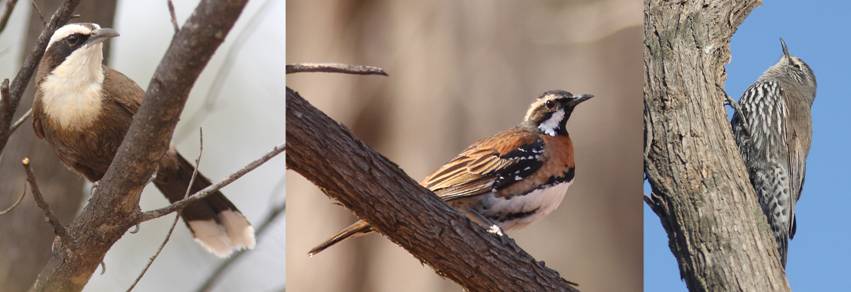This was my fourth visit to Bowra,
the first being in 2003 when I made a little video on the bird life there,
which I showed at a COG meeting. Quite a few Canberrans have now visited
the property. The sale by the McLarens to Australian Wildlife Conservancy
was to take effect at the end of the September, the arrangement being that Ian
and Julie will act as interim managers until next July (they now live in
Cunnamulla itself) while AWC decides on long-term management arrangements.
A very noticeable change from 2003
is the popularity of the place with visitors. The previously scrubby
surrounds of the little artificial wetland are now a ‘lawn’.
In the 6 days I was there, there were never less than a half-dozen separate
sets of campers, and sometimes a full dozen, with a daily round of comings and
goings. Basically, there are 2 kinds of bird-watching at Bowra.
First, you can stay around the bird-intensive vicinity of the little bore-fed
wetland which attracts a fair quota of unlikely aquatic species (there was a
pair of stilts with young), and also a suite of dry-country bush-birds that are
by now even more habituated to human presence, so they offer close views.
These latter include 3 parties of Chestnut-crowned Babblers that kangaroo-hop
over the ‘lawn’, and a number of Spotted Bowerbirds. [If AWC
decides to close off the bore, this community will be considerably diminished,
I think.] Secondly, the more serious birdwatcher will certainly undertake
a tramp or two through the extensive brown-pebbled Mulga country to find the
local specialities: Hall’s Babbler, Chestnut-breasted Quail-thrush
and White-browed Treecreeper:

While I was there, the more
energetic parties reported finding Redthroat and Bourke’s Parrot, and a
rather less probable Black-breasted Buzzard (none seen by me, and all species
surely close to the eastern limit of their respective ranges). There were
also definite sightings (not by me) of a Grey Falcon – on 2 occasions near
the campground. 5 of the 6 woodswallows were certainly about (not Dusky
so far as I know, although it does occur), and some groups had ‘all four
babbler species’ in the one day.
I anticipate that ‘What is
happening at Bowra’ will be a frequent topic among the growing number of
wide-ranging Australian birdwatchers. Decisions on the bores, the stock,
the stock dams, and the camping area will surely affect some species. I
am told that representations by the birdwatching community have led to an
informal indication by AWC that the place will remain open to birdwatching, but
on what terms remains to be seen. For example, it seems unlikely campfires
will be allowed. These have no doubt contributed to the creation of the ‘lawn’.
Many camping birdwatchers enjoy a good evening campfire, but I am not all
that keen on them, perhaps because there’s not much point when you’re
camping by yourself. Once at Bowra I pitched a tent a few ks down
the main track (you could camp literally anywhere), and Ian came along
and said ‘Ah you’ve found some Gidgee. That’ll make a
great fire.’ Coincidentally I later heard on the radio a country
song of yesteryear ‘Fire of Gidgee Coals’. On the drive home
I stopped at Athol Cooleman’s music museum in Cowra (where the Tree
Sparrows are, or used to be). He was kind enough to make me a tape of the
song by the original artist, which I still have, and it always reminds me
of Bowra for some reason.

